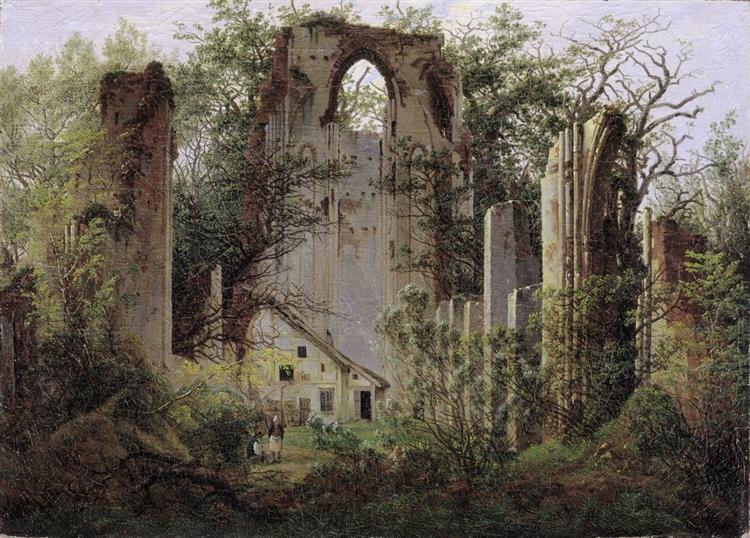Beskrivelse
Caspar David Friedrich's painting "Ruined Monastery at Eldena near Greifswald" created in 1825 is a flash of German Romanticism that encapsulates the deep connection between human beings, nature and the passage of time. Friedrich, who is considered one of the precursors of Romanticism, manages to capture an atmosphere of melancholy and contemplation in this work, elements characteristic of his style. The image presents a ruined monastery, surrounded by a natural landscape that seems to invite reflection.
The composition is masterfully balanced. The monastery, with its Gothic arches and deteriorating architecture, is situated on the right side of the work, hinting at its past grandeur despite its current state. The ruins are highlighted by the use of earthy tones combined with a dramatic sky, characterized by clouds displaying a range of greys and blues. This sky, charged with emotion, seems to interact with the ruins, emphasizing the fragility of human existence in the face of the immensity of nature.
One of the most captivating aspects of this painting is the use of colour. Friedrich employs a palette that, despite its sobriety, transforms the ruin into a monument to the passing of time. The greens of the landscape not only suggest life, but also contrast with the greys and browns of the monastery, creating a visual tension that invites meditation. The details of the surroundings subtly fade into the background, adding depth and reinforcing the idea of the grandeur and sadness of the past.
There are no human figures in this work, a deliberate choice Friedrich often made to focus the viewer’s attention on the environment and architecture. However, the absence of characters does not prevent a reflective presence from being felt. In Friedrich’s visual narrative, ruins have been the setting for countless stories and memories, suggesting the individual’s quest to find his place in the world. This omission of the human figure also resonates with the Romantic philosophy of man’s insignificance in the face of the grandeur of nature and time.
Friedrich was known for his ability to evoke a sense of the sublime, and in Ruined Monastery at Eldena, this is manifested through the brooding landscape surrounding the decaying structure. The monastery does not merely represent a ruined building, but also stands as a symbol of ephemerality and the search for meaning in life. The combination of the natural and the architectural in his work reflects the integration of man with the environment and the inevitable deterioration of all things.
This painting, from the collection of the Leipzig Museum of Fine Arts, is a testament to Friedrich's interest in history, spirituality and nature. His sensitivity to light and space, along with his ability to capture the essence of a place, makes this work one of Friedrich's many lasting contributions to the art world. The painting invites the viewer to pause and contemplate not only the landscape depicted, but also the reflection of their own existence in a changing and often time-worn world.
"Eldena Monastery Ruins near Greifswald" is undoubtedly a masterpiece that encapsulates the soul of Romanticism and the dialogue between humanity and nature, consolidating Caspar David Friedrich as a master of historical and landscape painting.
KUADROS ©, a famous painting on your wall.
Hand-made oil painting reproductions, with the quality of professional artists and the distinctive seal of KUADROS ©.
Painting reproduction service with satisfaction guarantee. If you are not completely satisfied with the replica of your painting, we will refund 100% of your money.

